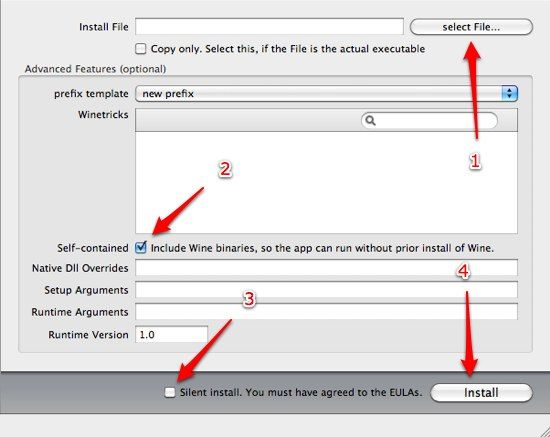

- How to use winebottler for mac install#
- How to use winebottler for mac code#
- How to use winebottler for mac free#
- How to use winebottler for mac mac#

Do not tap anything else on the page while waiting for the SKIP AD to pop up. Press SKIP AD which will appear in the top-right corner of the screen after five seconds. This will redirect you to an advertising screen. If you’re running anything below OS X Capitan, tap the WineBottler 1.6.1 Stable option. Press the “WineBottler 1.8-rc4 Development” button which is in the middle of the page with a green arrow on it. If your EXE file won’t run on WINE, you’ll definitely need to use Boot Camp. WINE is basically an advanced program, but WineBottler is a user-friendly interface to WINE.
How to use winebottler for mac mac#
If you are using one of those products, please retest in plain Wine before filing bugs, submitting AppDB test reports, or asking for help on the forum or in IRC.Method 1 : Using WINE to Open EXE Files on Mac STEP Third party versions of Wine, such as Wineskin, Winebottler, and PlayOnMac, are not supported by WineHQ. Note: Files in this directory are unused on macOS unless you use a UNIX window manager and other X11 applications instead of the native MacOS apps.
How to use winebottler for mac free#
How to use winebottler for mac code#
Then simply delete your local Wine source code directory: Otherwise and if you used `sudo make install`, revert it: Replace wine with wine-devel if you installed the development version. Sudo port uninstall -follow-dependencies wine Using MacPorts, uninstall the wine package you previously installed: See Building Wine on macOS Uninstalling Wineīrew uninstall -cask (selected wine package) The -no-quarantine line to used to above brew adding the quarantine bit The advantage of installing via homebrew means wine is available from a standard terminal session Wine-stable, wine-devel or wine-staging packages can be installed using the above example.
How to use winebottler for mac install#
To install wine the following command can be used īrew install -cask -no-quarantine (selected wine package) Winehq packages can be installed using homebrew Installing Winehq packages using homebrew There is no need to set DYLD_* environment variables all paths are relative, so it should work as long as the directory structure is preserved (you can skip the /usr prefix though using -strip-components 1). To install from a tarball archive, simply unpack it into any directory. For user convenience, the package also associates itself with all *.exe files, which means you can run windows executables just by double-clicking on them. from the Terminal, as the PATH variable is set correctly. You can now directly start wine/winecfg/. By clicking on it, a new Terminal window opens with a short introduction into some important wine commands. After the installation is finished, you should find an entry "Wine Staging" or "Wine Devel" in your Launchpad. It is possible to install the package either for all users (needs administrator privileges), or just for your current user.

pkg file, double-click on the package, and the usual macOS installer wizard should open. pkg file is recommended for inexperienced users. pkg files and tarball archives are available at.


 0 kommentar(er)
0 kommentar(er)
